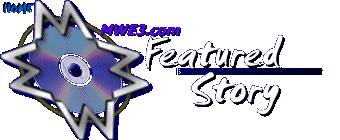Sleep Walk 2011
an interview with
Santo & Johnny’s
JOHNNY FARINA
written and conducted by Robert Silverstein
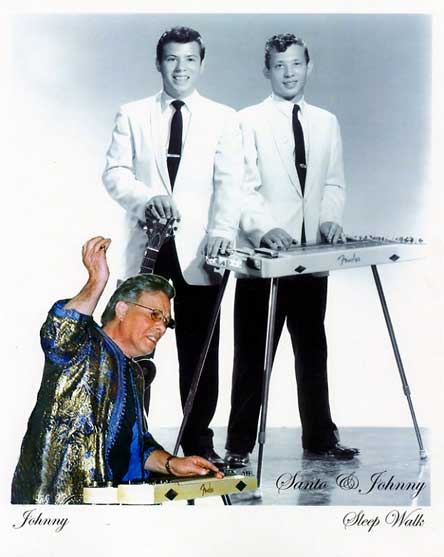 A
defining musical moment signaling the end of the 1950’s and the
dawn of 1960, “Sleep Walk” was a number one smash for New
York’s own Santo & Johnny way back in 1959. An evocative
instrumental spotlighting the brother’s unique steel guitar sound,
“Sleep Walk” has seen numerous covers by thousands of guitarists
since, including Santo & Johnny fans Larry Carlton and Brian Setzer.
A song classic with a great history, “Sleep Walk” was originally
written and recorded by Johnny Farina and his brother Santo. Speaking
to this rock 'n' roll pioneer near the end of the first decade of
the 21st century, it's clear the Long Island-based Johnny Farina continues
hearing new artists cover his song and he keeps it evergreen on various
compilations and new CDs of his own. While Santo & Johnny recorded
numerous albums back in the day, now the property of Sony/BMG, Johnny
Farina has enjoyed a solo career of his own and as he’s released
several CDs under his own name including Pure Steel (1994 w/
newly added recordings from 2005), Christmas Mine (2003) and
Italian Being Served (2005). One of the most popular steel
guitar based instrumentals ever written, “Sleep Walk” hits
the 50 year milestone in 2009. In the following interview that first
appeared in the July 2008 issue of 20th Century Guitar magazine, Johnny
Farina had lots to say, especially about the song that touched so
many people back in 1959.
A
defining musical moment signaling the end of the 1950’s and the
dawn of 1960, “Sleep Walk” was a number one smash for New
York’s own Santo & Johnny way back in 1959. An evocative
instrumental spotlighting the brother’s unique steel guitar sound,
“Sleep Walk” has seen numerous covers by thousands of guitarists
since, including Santo & Johnny fans Larry Carlton and Brian Setzer.
A song classic with a great history, “Sleep Walk” was originally
written and recorded by Johnny Farina and his brother Santo. Speaking
to this rock 'n' roll pioneer near the end of the first decade of
the 21st century, it's clear the Long Island-based Johnny Farina continues
hearing new artists cover his song and he keeps it evergreen on various
compilations and new CDs of his own. While Santo & Johnny recorded
numerous albums back in the day, now the property of Sony/BMG, Johnny
Farina has enjoyed a solo career of his own and as he’s released
several CDs under his own name including Pure Steel (1994 w/
newly added recordings from 2005), Christmas Mine (2003) and
Italian Being Served (2005). One of the most popular steel
guitar based instrumentals ever written, “Sleep Walk” hits
the 50 year milestone in 2009. In the following interview that first
appeared in the July 2008 issue of 20th Century Guitar magazine, Johnny
Farina had lots to say, especially about the song that touched so
many people back in 1959.
{On March 24, 2011 I had dinner with Johnny Farina and his wife
Rosemary. It was a festive occasion for me indeed as Johnny had prepared
and presented me with a CD featuring seven new instrumental tracks
that gives a new meaning to the term “guitar legend” in
the 21st century. As the co-founder of Santo & Johnny, he had
a trendsetting number one and decade changing hit with “Sleep
Walk” at age 17. 52 years later, Johnny Farina clearly has some
great music still inside him especially as evidenced by these incredible
new tracks. Johnny’s 2011 single, entitled “The Big”
captures an amazing sense of musical excitement and presents today's
audience with a transformation of the classic '50s Santo & Johnny
instrumental steel guitar based sound. The b-side is another new track
called “Steel Guitar Rag” which simply must be heard to
be believed. No one since “Sleep Walk” back in 1959 has
been able to recreate that original sound but on his “Sleep
Walk 2011” remake Johnny comes as close as anyone, including
the legends who made the song part of their repertoire over the years—guitar
heroes like Brian Setzer, Larry Carlton and Hank B. Marvin. Another
new Farina track “A Little Framboise” is definitely the
first steel guitar based disco instrumental I ever heard! Also freshly
minted from S&J’s Johnny Farina in 2011 are instrumental
covers of ‘50s classics "In
The Still Of The Night", “Venus”
and “You
Don’t Know Me”. Johnny is heading over to the U.K. in
June for some shows and I hear there’s even talk of hopefully
bringing the “Sleep Walk” sound down under for a tour of
Australia in 2012. Even as “Sleep Walk” continues to grow
in stature and history, with the original and numerous covers still
delighting millions of listeners world wide, let’s hope Johnny
gets to release and continue to play his still vital guitar music.
Offering yet another look back at the classic that is "Sleep
Walk", mwe3.com presents the full length version of the Johnny
Farina interview. The following interview with Johnny Farina originally
appeared in edited form in the July 2008 issue of 20th Century Guitar
magazine, which after 17 years, suddenly closed down in January 2009.
- Robert Silverstein March 29, 2011}
______________________________
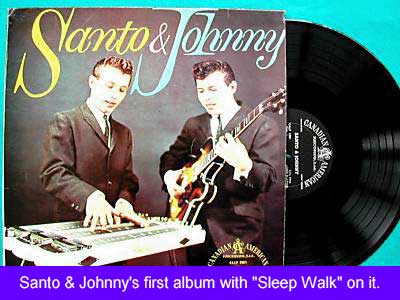 JF:
“Sleep Walk” hit in ‘59. So how old were you in ‘59?
JF:
“Sleep Walk” hit in ‘59. So how old were you in ‘59?
MWE3: Yeah, I was only 5 years old. (laughter)
JF: Oh! Did you listen to the radio?
MWE3: I was too busy watching the Mickey Mouse club in Brooklyn. (laughter)
I know you have a few solo CDs out, Pure Steel, Christmas
Mine and Italian Being Served. Is Pure Steel the
most recent one?
JF: No, Pure Steel was the first one. For this first CD I chose
"Sleep Walk" because it became #1 and put Santo & Johnny
on the map, and "All Night Diner" because it was the flip
side of "Sleep Walk", and "Teardrop" because it
was the follow-up to "Sleep Walk". All 3 were written by
Santo & Johnny. "Caravan", "Summertime", "Ebb
Tide", "Enchanted Sea", were successes for us here
and also in Europe. As far as “And I Love Her,” the Beatles’
song, we had a hit with it in Mexico in 1965 and it was number 1 for
21 weeks.
I chose "Europa" because it is just a great song and just
lends to the steel. As a matter of fact after I finished the CD I
sent a copy to Santana who is co-writer of the song and he called
and told me how much he loved my version. He said it was so soulful.
"Ghost Riders in The Sky", when I was a kid I would listen
to Vaughn Monroe sing it on our old Emerson Radio. "Pipeline"
was a touch of surf music Farina style. "Judith", actually
I started writing it while I was on my boat. I was fishing and couldn't
catch a fish but hooked a seagull. I looked at it as a sign that I
should stop fishing and write a song. After letting the seagull go
I went into my cabin and turned on my 4 track and came up with the
melody. Actually some seagulls sounds were picked up with the mike
so when I did record it in the studio I put some seagulls on the track.
At this time I'm working on another CD and I have 4 tracks done. "You
Don't Know Me" and "In The Still of The Night", and
the other 2 tracks are originals that I think are pretty hot.
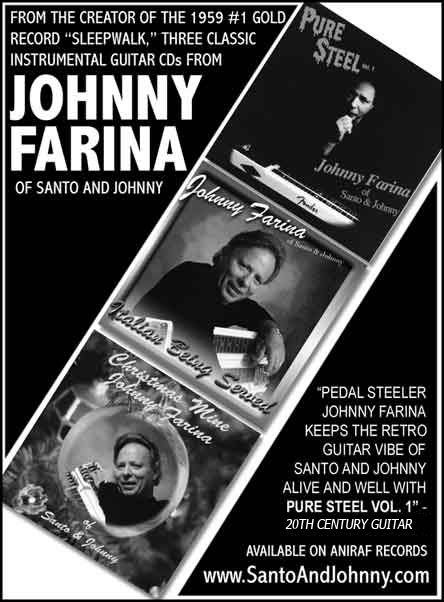 MWE3:
Did you play everything on the Pure Steel album?
MWE3:
Did you play everything on the Pure Steel album?
JF: I played my 1956 Fender Stringmaster steel on all the tracks.
On "Ghost Riders", "Pipeline", "Ebb Tide",
"Sleep Walk", and "Judith", I played both steel
and rhythm guitars and had some studio musicians at the session. I
used a Roland 1680 work station and a Boss drum machine on the Christmas
and Italian CD and actually had my son play bass on Tears of Silent
Night.
MWE3: What guitars are you playing on the Pure Steel record?
JF: I used a Fender Jazzmaster, I used a 70's Gibson Barney Kessel
model guitar, I used my 70's Maple Neck Blonde Les Paul, which Les
signed when I played with him at the Iridium Club in NYC. Les is a
genius and a warm person.
MWE3: Sounds like you’re also featuring some other electric guitars
on the CD.
JF: One of the guys was playing, I guess he was using a Strat and
a nylon string guitar on "Europa".
MWE3: It’s amazing that while your father was stationed in the
Army he actually had the idea to make you and Santo steel guitarists.
I was thinking that’s a very unusual sound for somebody from
Brooklyn.
JF: (laughter) You know what’s funny about that whole scene?
My father was born in Italy and he came to the States when he was
nine years old. He was surrounded by mandolin players and accordion
players all his life. Later on, gets married, has two sons and he
gets drafted. And when he gets drafted into the army, first he was
stationed in Texas and then Oklahoma. And he heard this steel guitar
on the radio. And he was so infatuated with the sound of it that he
wrote home to my mom. He gave the order, ‘Just have the boys
learn how to play this beautiful instrument. I think it’s called
the steel guitar or Hawaiian guitar.’
Needless to say, years ago things were different. When the parents
gave instructions, children would listen. So my mom tried to get some
lessons for us. So she took us to a store in Brooklyn, on Court Street,
not far from the Brooklyn Bridge. Just about that time my father got
discharged from the Army, so he took us for lessons. After about the
seventh lesson my father was getting really depressed with the whole
thing because (laughter) we didn’t sound like the guy on the
radio. He wanted to hear some Country and Western. Well we didn’t
take any more lessons.
Then somebody told us about Eddie Bell. He was a Gibson guitar dealer
and my father bought a six string lap Gibson guitar and a small little
amplifier. Then he turned us on to this Hawaiian musician, who played
at the Lexington Hotel in Manhattan. There was a Hawaiian room there.
He used to play at the hula girl show there. So we went to his house.
He showed us some things on the guitar and he said, 'You really have
to be dedicated to this instrument because it's not played like a
regular guitar because you make the frets with your steel bar. You
must place your steel exactly on the fret line, otherwise you'll be
sharp or flat and also develop a vibrato and must play it with much
feeling, and hold the steel bar flat so it does not cause any vibration.
And last but not least you have to have a good ear.
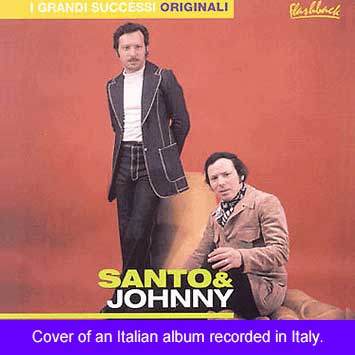 MWE3:
How did your early steel guitar experiences lead to “Sleep Walk”
becoming such a huge success?
MWE3:
How did your early steel guitar experiences lead to “Sleep Walk”
becoming such a huge success?
JF: We would started to play at family functions. Naturally every
time there’d be a party or a wedding they would say, ‘Oh
Santo & Johnny are going to play.’ ‘Cause we were kids.
And then before you know it, it was just like, ‘Wow, we should
play in clubs and things.’ I guess I was almost 15. My brother
is four years older then I am.
We started to play at some church dances first. Then we did some clubs
in Brooklyn and we started to get a following. We would do a lot of
cover material. And after we would finish playing at night, we would
go to the favorite greasy spoon and have breakfast with some of our
fans and we would go home and we would start jamming ‘cause we
couldn’t sleep, we were wound. We would start incorporating some
of our original songs into some of the clubs that we would play at.
Whatever was top 40 at the time, and play them instrumentally.
We added “Sleep Walk”, and “All Night Diner” to
our song list. These were songs that we wrote, and thought were really
good. At age 16 I quit school so I could peddle our songs. So for
about a year and a half I shopped three demos around. One side was
“Sleep Walk” and the other side was “All Night Diner,”
and the other one was a vocal that I sang on called “Take A Chance”.
Needless to say, everything was doo-wop. There wasn’t too much
interest in hearing anybody trying to peddle steel guitar records.
And I told them, ‘this is a steel guitar but it’s not like
anything you’ve heard before.’ They assumed it was going
to be like a country sound or Hawaiian sound. They would want me to
leave the record there but I only had one of each and I couldn’t
do that. So, they would always tell me the same thing, ‘Okay
kid, get lost.’
So I then shopped the Brill building, which was the place to go. After
I got my fill of record companies, I decided to go to see publishers.
I read a book about publishers and then bought a book with the addresses
of publishers in Manhattan. They all had the same story. Either they
weren’t interested or they wanted me to leave it. One day, as
usual I choose by random Trinity Music. I said ‘Wow, this sounds
like this could be a sign.’ (laughter) I’m looking for anything
now you know? I said, ‘Maybe this is a sign that God wants me
to go to the Trinity. The father, the son and the holy ghost.’
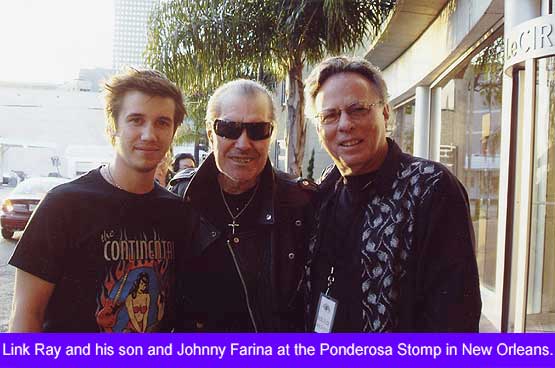 So
I went to 101 West 55 street. And I go to the door of Trinity music
and it’s slightly open. It was around lunch time. I stuck my
head in and there was a man sitting down at his desk. He was about
to eat a pastrami sandwich. And he tells me, ‘Hey kid! I know
you have a hit record.’ Well, that was all I needed. I said,
‘Yeah, I do. How do you know?’ And he said, ‘Everybody
has a hit record.’ And I said, ‘Yeah, but I really do.’
And he said, ‘Leave it. I’m going to have my sandwich now.
I don’t have time to listen to your record now. I’ll listen
to it later.’ I said, ‘Well, if you don’t listen to
it now, you’re not going to listen to it later, ‘cause I’m
walking out.’ He said, ‘You can leave it, or you can go.’
I said, ‘I’m going to go.’ He said, ‘Well, go.’
I said, ‘You’ll kick yourself in the ass someday.’
So
I went to 101 West 55 street. And I go to the door of Trinity music
and it’s slightly open. It was around lunch time. I stuck my
head in and there was a man sitting down at his desk. He was about
to eat a pastrami sandwich. And he tells me, ‘Hey kid! I know
you have a hit record.’ Well, that was all I needed. I said,
‘Yeah, I do. How do you know?’ And he said, ‘Everybody
has a hit record.’ And I said, ‘Yeah, but I really do.’
And he said, ‘Leave it. I’m going to have my sandwich now.
I don’t have time to listen to your record now. I’ll listen
to it later.’ I said, ‘Well, if you don’t listen to
it now, you’re not going to listen to it later, ‘cause I’m
walking out.’ He said, ‘You can leave it, or you can go.’
I said, ‘I’m going to go.’ He said, ‘Well, go.’
I said, ‘You’ll kick yourself in the ass someday.’
And at that point, he said, ‘Okay, come on in. Put it on the
Victrola.’ He had this little machine. Well I put it on there.
And he liked it as soon as he heard it. He was a publisher. He also
had Eddy Arnold signed. He said, ‘Hey, you want some sandwich,’
and that’s it. After that, I knew I was in. And then he said,
‘This is really great. What kind of instrument is it?’ And
I told him it's a steel guitar. He said, ‘I never heard it played
that way.’ I said, ‘Well, it’s different. It’s
rock and roll now. This is what we do. We play rock and roll on it.
We don’t play country music.’ And he was so excited about
it that he said, ‘Are you signed with anybody?’ (laughter)
And I said, ‘No, I’m not signed with anybody. We’re
free.’ So he had us sign a contract.
Naturally I went home. I think I ran home from New York. But actually,
I took the train. I was running in my seat. I couldn’t believe
I had a deal. We didn’t sign anything because first of all, I
was a minor. So my father had to sign for me. Naturally, my brother
could sign for himself because he was 20 now.
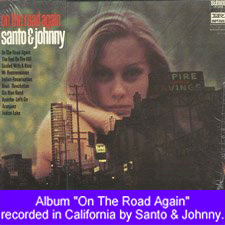 The
man's name was Ed Burton and he also became our manager. He secured
the deal with Canadian American. Alan Freed broke the record in New
York. When Alan Freed heard it, he said, ‘This record will never
die.’ And he was right. ‘Cause “Sleep Walk” will
be 50 years old next year and it gets played more than ever. It’s
always in movies, commercials. It’s always happening.
The
man's name was Ed Burton and he also became our manager. He secured
the deal with Canadian American. Alan Freed broke the record in New
York. When Alan Freed heard it, he said, ‘This record will never
die.’ And he was right. ‘Cause “Sleep Walk” will
be 50 years old next year and it gets played more than ever. It’s
always in movies, commercials. It’s always happening.
MWE3: Was that company based in New York or Canada?
JF: Actually, they said it was based out of Winnipeg, Canada but they
had the office in Manhattan. I think they had one or two records out
before ours, but had no success. "Sleep Walk" made Canadian
American Records a successful record company.
MWE3: 1959 was a turning point year for music in general.
JF: I can only say, the instrumentals were very strong that year.
In the ‘50s there were great groups out there. There was Duane,
Johnny And The Hurricanes, The Ventures, The Champs, Floyd Cramer
had his sound also. Percy Faith for the string sound. There were a
lot of instrumentals. Instrumentals had their place. It’s ironic,
now in today’s market, especially the classic rock, ‘50s
and ‘60, on the shows, I’m the only instrumental act that
works this circuit. It looks like the promoters, for some reason,
are afraid to book instrumentalists. I don’t know what their
story is.
MWE3: Can you remember the final take on “Sleep Walk” in
the studio and who played on that track with you and Santo?
JF: No, jeez you’re going back 50 years now! (laughter) It’s
like a long time ago. I know there were studio musicians. They were
just there. In those days, I don’t know if that still holds true,
but they had a club. They used to call it the drummer club, guitar
club. And what they would do, at the guitar club, there’d be
one amplifier let’s say, that the guys wanted to use and everybody
would use that one. Instead of the musicians carrying their equipment,
the same held true for the drummer club. That’s what they had
in those days. I’d certainly see the same musicians mostly. If
they did our session, then they’d do the other guys session.
You had to be in the loop. And I don’t remember the names of
any of the men. They were much older then we were too. We were like
kids! (laughter) We were kids and we were playing with the old guys.
But they were excellent musicians.
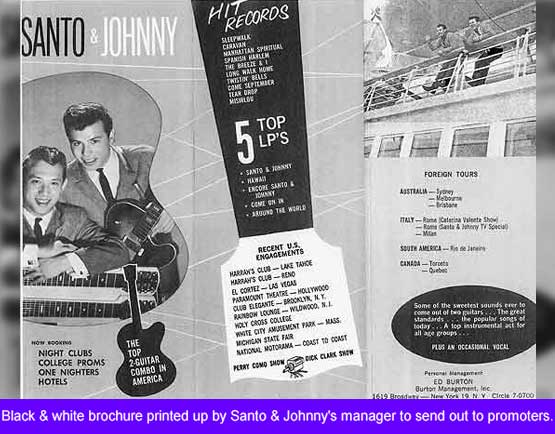 MWE3:
It seems like “Sleep Walk” has always been there but it
still sounds fresh.
MWE3:
It seems like “Sleep Walk” has always been there but it
still sounds fresh.
JF: It’s in everybody’s DNA you know? I think it's magical
and fits in any period of time.
MWE3: My favorite cover of “Sleep Walk” was on the first
Shadows album from 1961.
JF: Cliff Richard?
MWE3: The Shadows did it on their first studio album from 1961. That
mono mix is my favorite.
JF: No I didn’t hear that. I’d like to. Maybe you could
MP3 that to me.
MWE3: I call it a positive nostalgia song.
JF: It touches a lot of people for different reasons.
MWE3: Is there ever going to be a Santo & Johnny box set or a
compilation.
JF: I can only tell you BMG releases much of our stuff throughout
Europe especially in Italy, and some in the US and Canada. Sony BMG
has the masters in Italy now. We had big success with everything we
released in Italy. There wasn’t a house in Italy that didn’t
have a Santo & Johnny album. From ‘62 to ‘73, between
New York, California and Italy, we did over 40 albums. In 1959 “Sleep
Walk” was a huge hit in Italy and brought us there in 1962. In
'73 we hit with the Godfather Theme and broke all records for a record
holding the #1 position for 26 weeks. Well, we did a Beatles covers
album and one of the songs was “And I Love Her” which was
released in Mexico in 1965 and held the #1 position for 21 weeks in
Mexico. It's funny I played Mexico about 3 years ago and the disc
jockey told me that many people believed that the Beatles copied us
with "And I Love Her". Another funny story was an album
came out called "A Toot A Snore in '64". It was an underground
LP of a live session in LA at John Lennon's house studio. Paul McCartney,
Stevie Wonder and other people. They recorded the live session and
on it John Lennon picks up a guitar and starts strumming the chords
to Sleep Walk and starts singing jokingly the words Nightmare etc...
and then laughs and says no this is not Nightmare this is Santo &
Johnny's "Sleep Walk". I bought this CD on eBay.
MWE3: Who owns the UA / Imperial recordings now?
JF: All the masters, Sony BMG has everything.
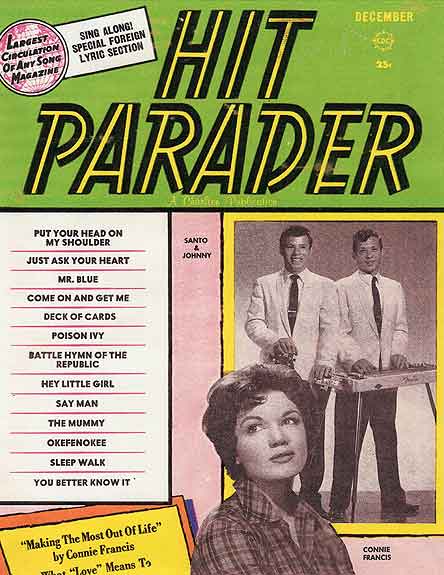 MWE3:
How come they don’t do something with those classic Santo &
Johnny albums from the Imperial days?
MWE3:
How come they don’t do something with those classic Santo &
Johnny albums from the Imperial days?
JF: Well, here again. It’s the mentality of the record people
today. I think they sort of pass up a lot of good things that are
still around.
MWE3: I wanted to ask about Santo. What’s he doing these days?
JF: Yeah, Santo is retired. In ‘73 he decided that would be it.
MWE3: It’d be great to give “Sleep Walk” some new recognition.
JF: There’s always things I want to do. I thought it would be
great to put a “Sleep Walk” tour on ‘cause it turns
50 next year. And get like a Brian Setzer, The Ventures, Joe Satriani
and a Larry Carlton together with myself and do a package show and
just do a tour of cities. Everybody knows “Sleep Walk.”
It’s just not a hit in Brooklyn or Jersey. I think it could be
a different kind of tour. I’ve seen Brian Setzer and I’ve
talked to Joe Satriani. Never about this project. I’ve met with
Larry Carlton some years ago when he had a huge success with “Sleep
Walk.” He had a number five jazz album with it.
MWE3: I was reading that there were originally some words for “Sleep
Walk”?
JF: When “Sleep Walk” became a hit, the publishers decided
that they should add some lyrics to it and try to get more longevity
and money out of it. They were totally wrong about that one. A girl
did a fine job on it. Her name was Betsy Brye. The vocal came out
in ‘59 and really nothing ever happened with it. Later on, The
Lettermen tried it, Diana Ross and The Supremes tried it. It was born
instrumental, it’ll always be instrumental.
MWE3: It’s probably among the most famous American pop instrumentals
ever done.
JF: Let’s face it, the song is unique, the sound is unique. When
you hear "Sleep Walk", you know immediately, ‘Hey,
I know that song. I know who it is.’ It’s got it’s
trademark. A lot of guitarists that I run across, tell me their first
song that they learned how to play was “Sleep Walk.” They
all try to get that sound.
MWE3: Well, like you said, so many guitarists, including Brian Setzer.
You worked with him...
JF: No, I didn’t work with him. I went to go see him at the Mohegan
Sun. I sent him a note and he invited me to go hang out with him.
Then he wanted to introduce me to the crowd. He was funny. I wanted
to ask him, ‘Why did you record “Sleep Walk” twice?’
It’s on his Chu Chu Fish album and then it’s on the
one he won the Grammy for, on Dirty Boogie. And he said, ‘It’s
just a great song man.’ So he wanted to introduce me to the crowd
and it was funny. He said, ‘I’m a little nervous up here.’
He plays “Sleep Walk” on every show. Brian is just an amazing
guitarist, one of the greats.
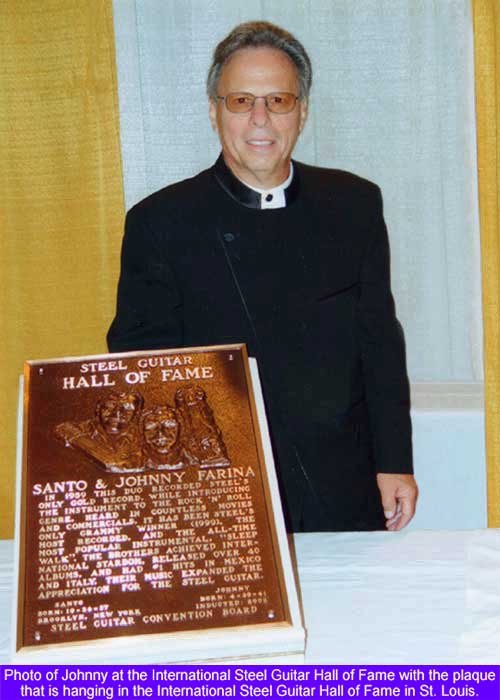 MWE3:
“Sleep Walk” sounds like a Rock and Roll hall of fame song
to me.
MWE3:
“Sleep Walk” sounds like a Rock and Roll hall of fame song
to me.
JF: I would think so. They sold a lot of records and Fender steel
guitars with that song.
MWE3: “Sleep Walk” was unique in that it was a big influence
on the singers and the rock and roll guys from that era too.
JF: It certainly got away from the norm. Everybody was doing doo-wop.
It’s funny. As I said, I do shows. It’s not doo-wop but
the people listen ‘cause it was part of their lives too when
they were growing up. The last song they would dance to at any kind
of ‘50s dance would have would be “Sleep Walk” ‘cause
you would know if you would get lucky. (laughter) That’s what
it was all about, romance. It's always being used...most recently
the Pretenders incorporated it in their new hit "Boots of Chinese
Plastic" in October 2008.
MWE3: I always felt “Sleep Walk” represented the transition
between the ‘50s and ‘60s.
JF: I can only say I agree.
MWE3: What are you personal favorite steel guitar albums?
JF: Funny question because, I was down in St. Louis, to be inducted
into the International Steel Guitar Hall of Fame, and a guy’s
doing a radio interview with me and he got annoyed because I said,
‘Listen, no I don’t have any favorite steel guitar players.
As a matter of fact, I don’t have a steel guitar record in my
house.’ They have the best of the best steelers playing all day
long. They’re country and western players. A couple of the old
timers came over to me and said, “Sleep Walk” put the steel
on the map, and brought the steel guitar into rock & roll. I said
we made our bones with “Sleep Walk.”
MWE3: I can’t think of another steel guitar instrumental that
became such a huge hit.
JF: There was no other. Like I said before, it's magical. Some fans
have said "it brings them tranquility".
MWE3: It’s sort of New York’s own steel guitar sound.
JF: It is the sound of Santo & Johnny, two Italian/American brothers
from Brooklyn, NY.
MWE3: “Sleep Walk” remains eternal.
JF: I enjoyed talking about it. Sometimes I just start talking about
other things because it’s been a very exciting life and there’s
a lot to say. I had no idea “Sleep Walk” would be around
for so many years. I knew when we did it, it was a magical thing that
took two kids from Brooklyn to Europe, to the Coliseum and eating
in the finest restaurants. But “Sleep Walk” has been very
good to me. It’s just more than my song. It’s really my
life.
Thanks to Johnny and Rosemary Farina @ www.santoandjohnny.com
